Have you ever seen a living fence? Maybe you want one but you’re confused about which plants to get. Well, there are many plant options for fence lines. You can choose creeping, climbers, dwarf trees, and shrubs. Shrubs are small to medium woody perennial plants. Shrubs can be used to create a privacy fence and add green foliage and color to your home.
Some of the best shrubs for fence lines include the Dwarf Hinoki Cypress Shrub, August Beauty Gardenia Shrub and so many more. Shrubs are usually recognized for their multiple stems and height as they do not grow as large as trees (6 to 10 meters). Shrubs can be evergreen or deciduous and make a good plant option for fence lines.
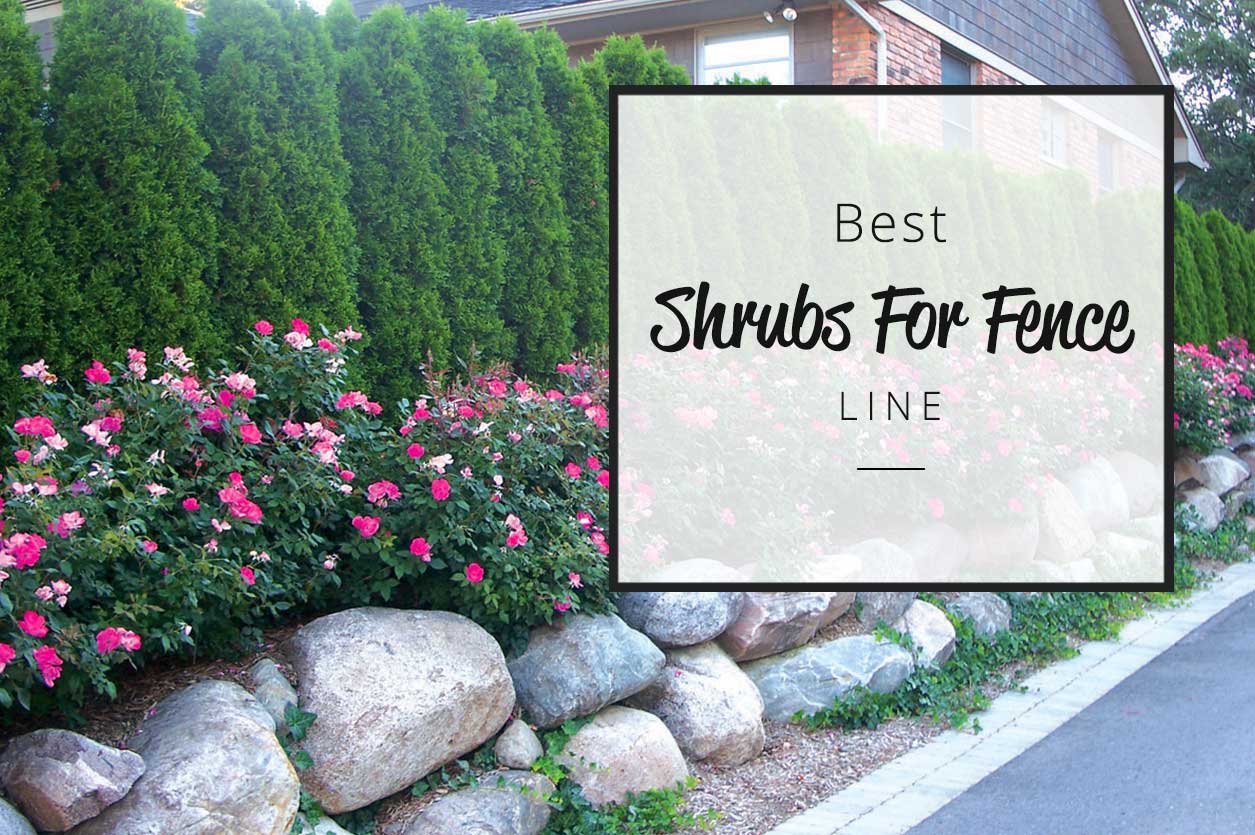
The best shrubs for fence line
The following shrubs are some of the best shrubs for a fence line. They come in different sizes, heights, and shapes. Some have bright flowers, dense foliage, and even berries. There are different varieties of shrubs for different growing zones, levels of care, types of aesthetics, etc.
1. Dwarf Hinoki Cypress Shrub
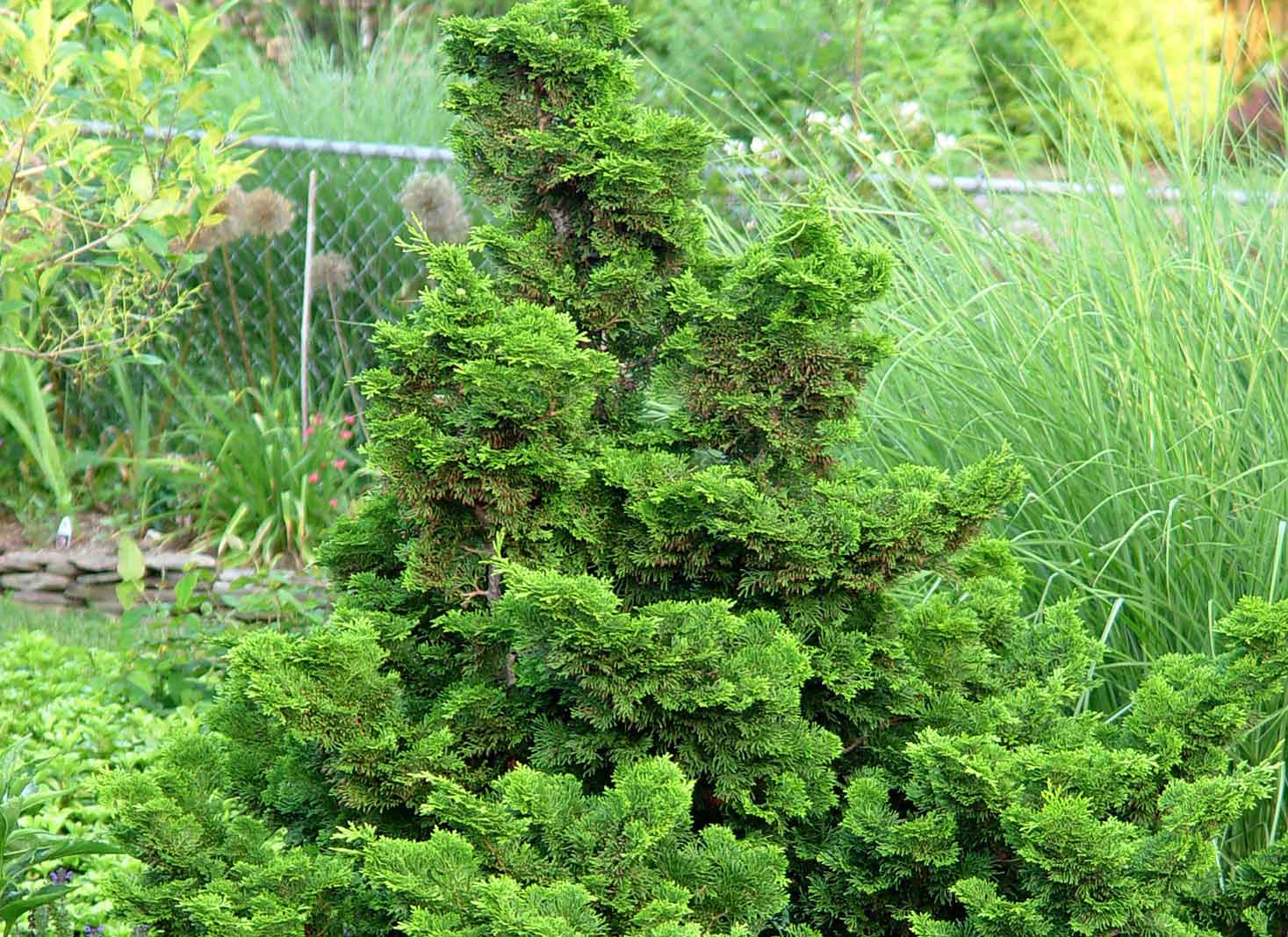
- Scientific name; Chamaecyparis obtusa ‘Nana Gracilis’
- Description; These shrub leaves grow in soft sprays on upright branches. The mature leaves are darker with a braided look and blend well with young light-green leaves.
- Maturity size; 4ft – 6ft tall.
- Level of care; very low-maintenance
- Hardiness Zone; zones 4 – 8
- Best conditions; it requires full sunlight exposure but can survive in minimal shade. Grows well on well-drained soil that is slightly acidic at a pH of 5.0 – 6.0.
The Dwarf Hinoki Cypress Shrub is one of the best shrubs for fence lines. The shrub can grow to 4 to 6 ft in height making it a good choice for a fence. It is tall enough to provide privacy to the homeowners and prevent onlookers from seeing into the yard. The tree is easy to maintain and grows well in full sunlight or minimal shade.
The soil should be slightly acidic and well-drained to provide optimum growing environments for the shrub. Make sure to water the shrub more frequently in dry seasons. Apply fertilizer in the second year to boost growth. Pruning of the shrub is not necessary unless you are looking to shape the tree into the desired form.
2. August Beauty Gardenia Shrub
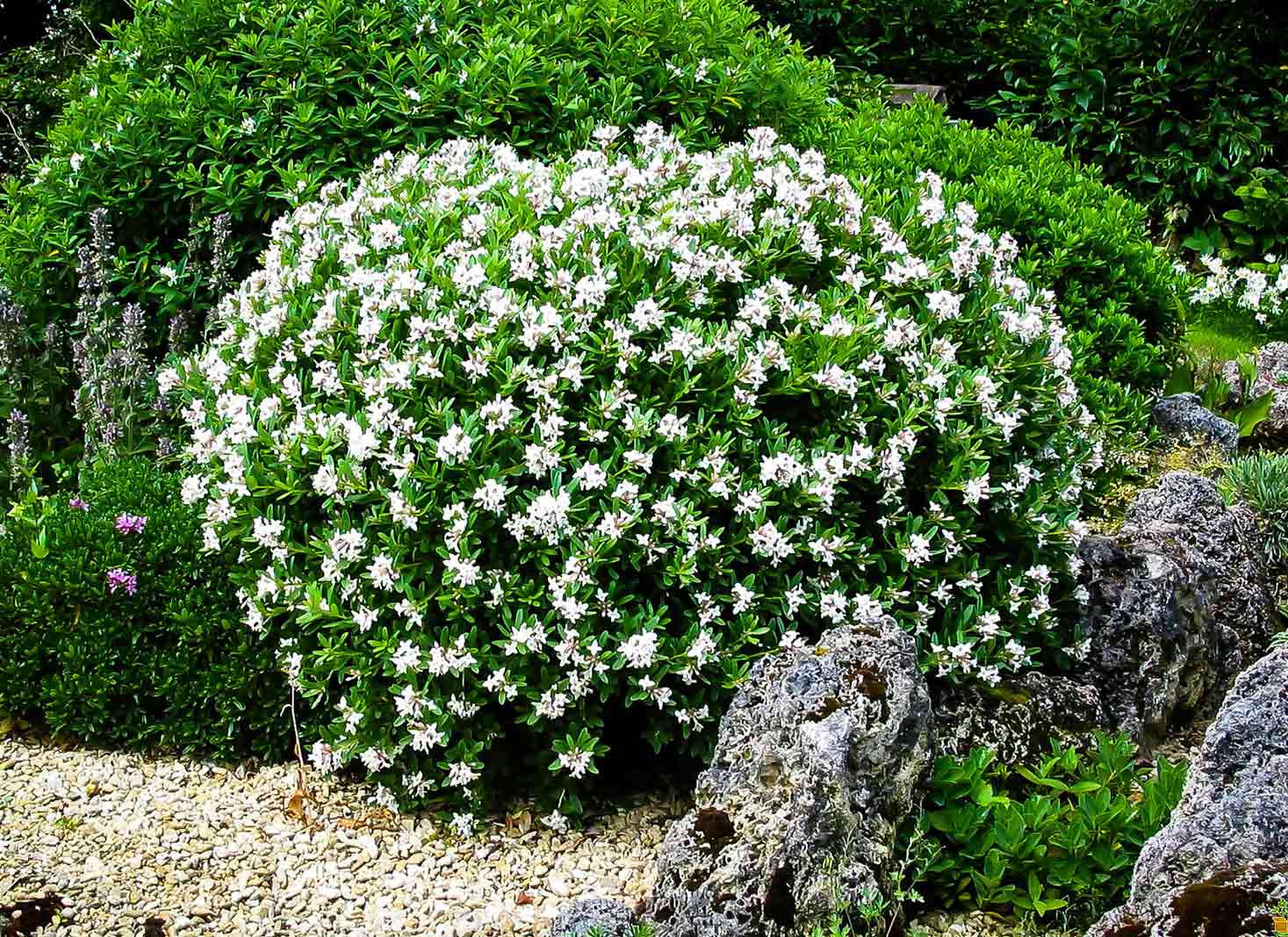
- Scientific name – Gardenia jasminoides
- Description – the shrub has dense, dark green tear-dropped shaped leaves that contrast well with the sharp white of its flowers
- Maturity size – 5ft tall and 3ft wide
- Level of care – water regularly, apply high-nitrogen fertilizer btw April-November and make sure to prune when blooming to improve air circulation and prevent overcrowding.
- Hardiness Zone – zone 8-11
- Best conditions – grows vigorously in full sunlight or minimal shade and slightly acidic soil with a pH of 5.0-6.0.
The August Beauty Gardenia Shrub is one of the best shrubs for fence lines. The shrub grows to about 5ft tall and 3ft wide. This plant has enough length and foliate to provide privacy, making it a good choice for a fence. The shrub blooms in the spring and has very beautifully highly scented double-petaled white flowers.
In good condition, the shrub will reach its maturity in about 3 – 4 years of planting and will be able to serve as a privacy fence all on its own. The August beauty gardenia shrub does require care and maintenance such as weekly waterings, fertilizer application mid-year, and regular pruning to remove dead flower heads and branches, etc.
3. Mohave Pyracantha (Firethorn) Shrub

- Scientific name – Pyracantha x ‘Mohave’
- Description – this shrub is an evergreen plant that grows upright. It has thorny stems and glossy green leaves. The shrub blooms in spring and has beautiful white flowers which later morph into red berries in the fall.
- Maturity size – 8 to 12 ft tall.
- Level of care – minimal watering weekly, apply slow release NPK in winter to aid flower and berry production in spring and fall, prune moderately to cut off dead branches and to shape the shrub into the desired form.
- Hardiness Zone – zones 6 – 9
- Best conditions – grows well in full sunlight, soil with good drainage, and slightly acidic or alkaline with a pH of 5.0 – 8.0.
The Mohave Pyracantha Shrub also known as the firethorn is a very good shrub for fence lines. The evergreen shrub can grow upright to about 8 to 12 ft. The upright nature of the firethorn shrub makes it a very good shrub for fences. The bright flowers and berries can also serve to add color to your property.
The firethorn shrub blooms in the spring and produces white flowers. These flowers morph into bright red-orange berries. These berries can cause a mild stomach ache when eaten in large portions by humans. However, they can be poisonous to cats and dogs. The firethorn shrub grows well in full sunlight, and well-drained soil with a slight acidity or alkalinity.
4. Korean Boxwood Shrub
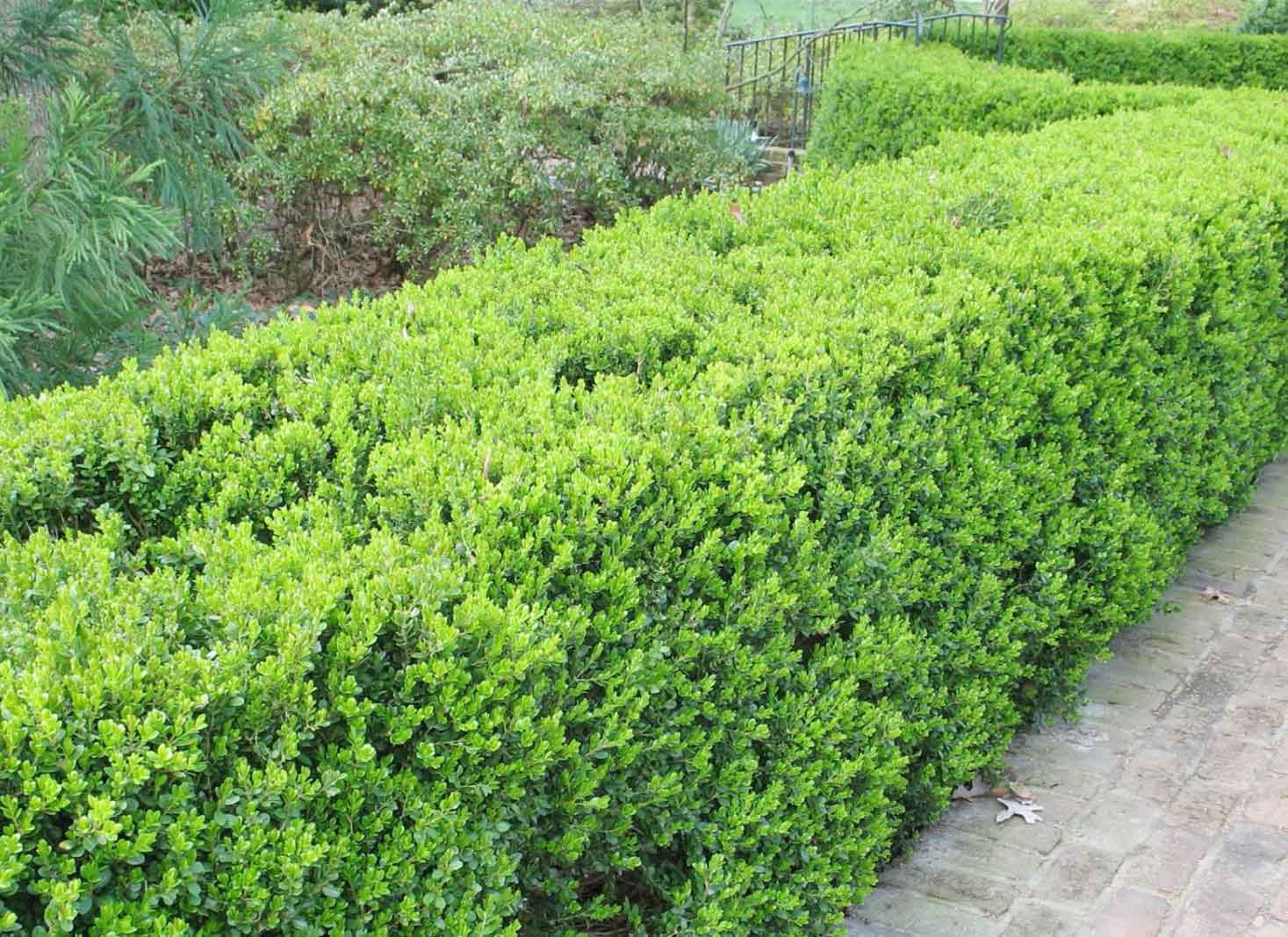
- Scientific name – Buxus sinica var. insularis ‘Wintergreen’
- Description – this shrub is evergreen with a dense arrangement of leaves in varying shades of green. It is well known for its ability to remain green through the coldest winters.
- Maturity size – 2 – 4ft tall.
- Level of care – very low maintenance. Require watering once biweekly, apply shrub fertilizer in spring if there are any signs of slow growth. Prune only dead branches or shape them into the desired form.
- Hardiness Zone – zones 4-9
- Best conditions – full sunlight, well-drained loamy soil that is mostly neutral with an ideal pH of 6.5 – 7.5.
Korean boxwood shrubs are one of the best shrubs for fence lines. The evergreen nature of the shrub combined with the dense foliage makes it a good border shrub. The Korean boxwood grows to about 4ft when mature. This makes it a poor choice if you’re looking for privacy. However, the short nature makes it a good choice for hedges or to mark out certain parts of a property neatly.
5. Skip Laurel Shrub
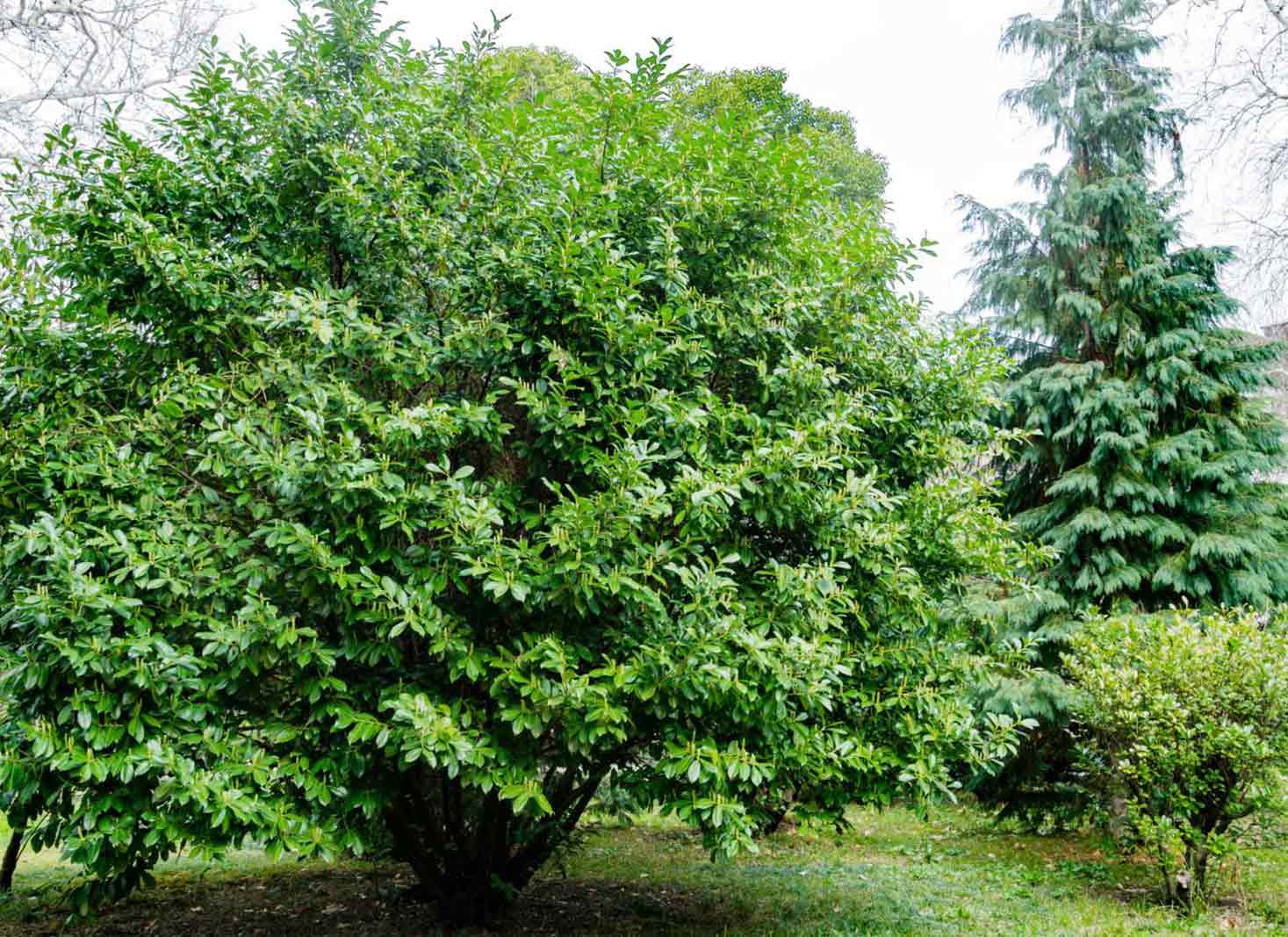
- Scientific name – Prunus laurocerasus
- Description; this shrub is a dense evergreen plant with dark green leaves. It doesn’t attract animals like deer and grows very tall when mature.
- Maturity size – 12 – 16 ft tall.
- Level of care – low maintenance. Water weekly and prune when necessary. You can also prune it into any specified shape.
- Hardiness Zone – zones 5 – 10.
- Best conditions – it can grow well in full, partial, or low sunlight, and almost all soils whether acidic or alkaline. It is a versatile and resilient plant.
The skip laurel shrub is one of the best shrubs for fence lines. The shrub has very dense foliage, and dark green leaves and is unattractive as food for herbivores. The skip laurel shrub is a very good choice for fences as the shrub can grow as tall as 12 to 16 ft when mature. It requires little maintenance and is good for beginners.
To keep a skip laurel shrub healthy, make sure to water it once weekly. You can prune to shape the shrub into a specified style.
6. Common Purple Lilac Shrub
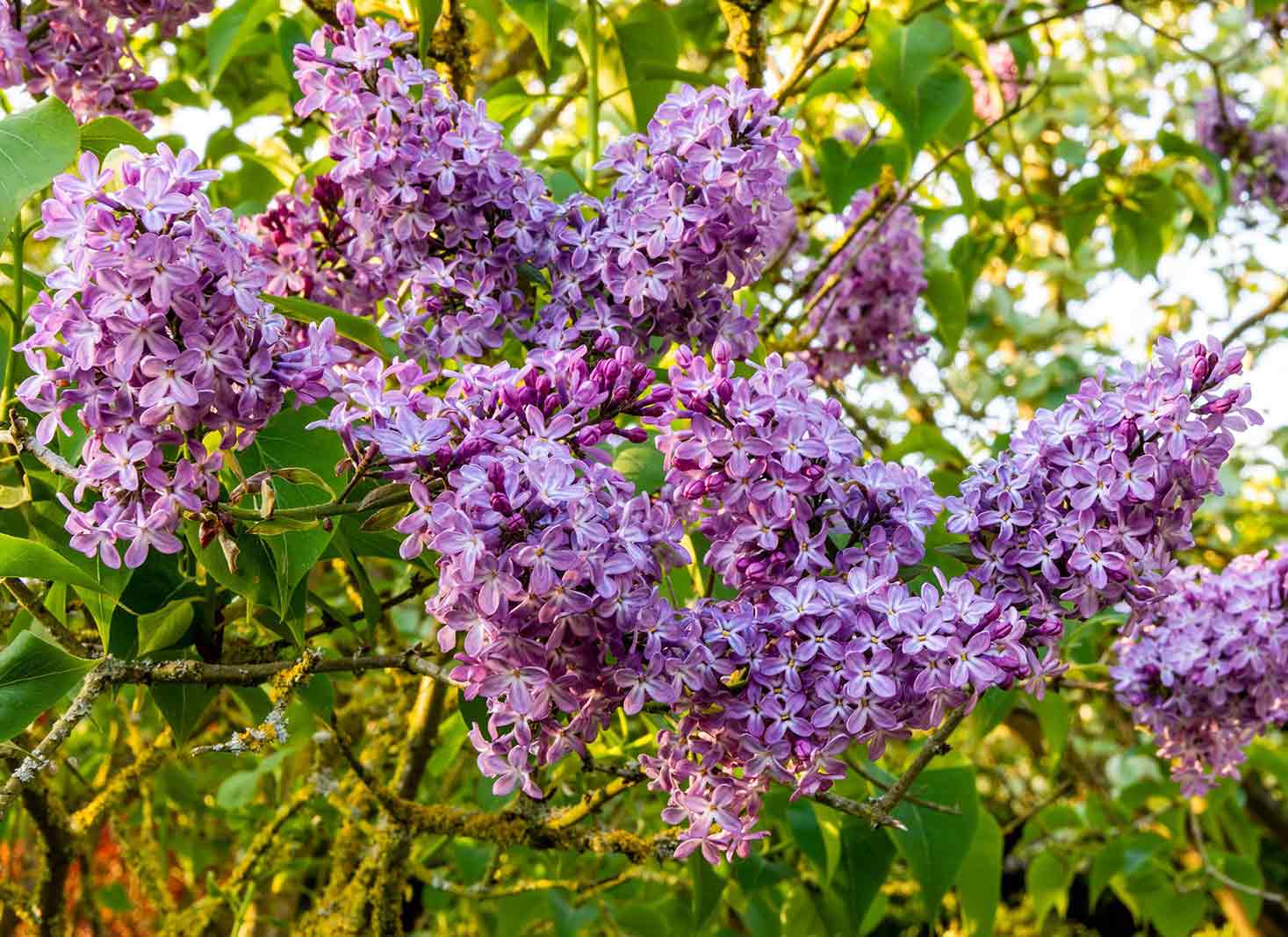
- Scientific name – Syringa vulgaris
- Description – this shrub is characterized by its colorful lilac flowers with a pleasant scent. These flowers bloom during springtime. The shrub is fast growing and grows both in height and width.
- Maturity size – 8-15 feet tall and 6-12 feet in width.
- Level of care – moderate care. They can survive in most soil conditions and do not attract pests. Regular pruning to cut off dead flowerheads and trim the shrub into the desired shape.
- Hardiness Zone – zone 3 – 7
- Best conditions – it grows well in full sunlight or partial trade. Can survive in most soil types and temperatures as low as -30℉.
The common purple lilac shrub is one of the best shrubs for fence lines. This shrub is well-recognized for its lilac flowers with a pleasant smell and sight. The purple lilac shrub is a very good choice for a privacy fence. The shrub is a fast-growing species and can grow to an average of 8-15 feet tall and 6-12 feet in width.
This shrub needs moderate care although it is resilient and has been found to survive in most soil types. You are to prune this shrub to remove deadheads and cut it into the desired shape.
7. Oakleaf Hydrangea Shrub
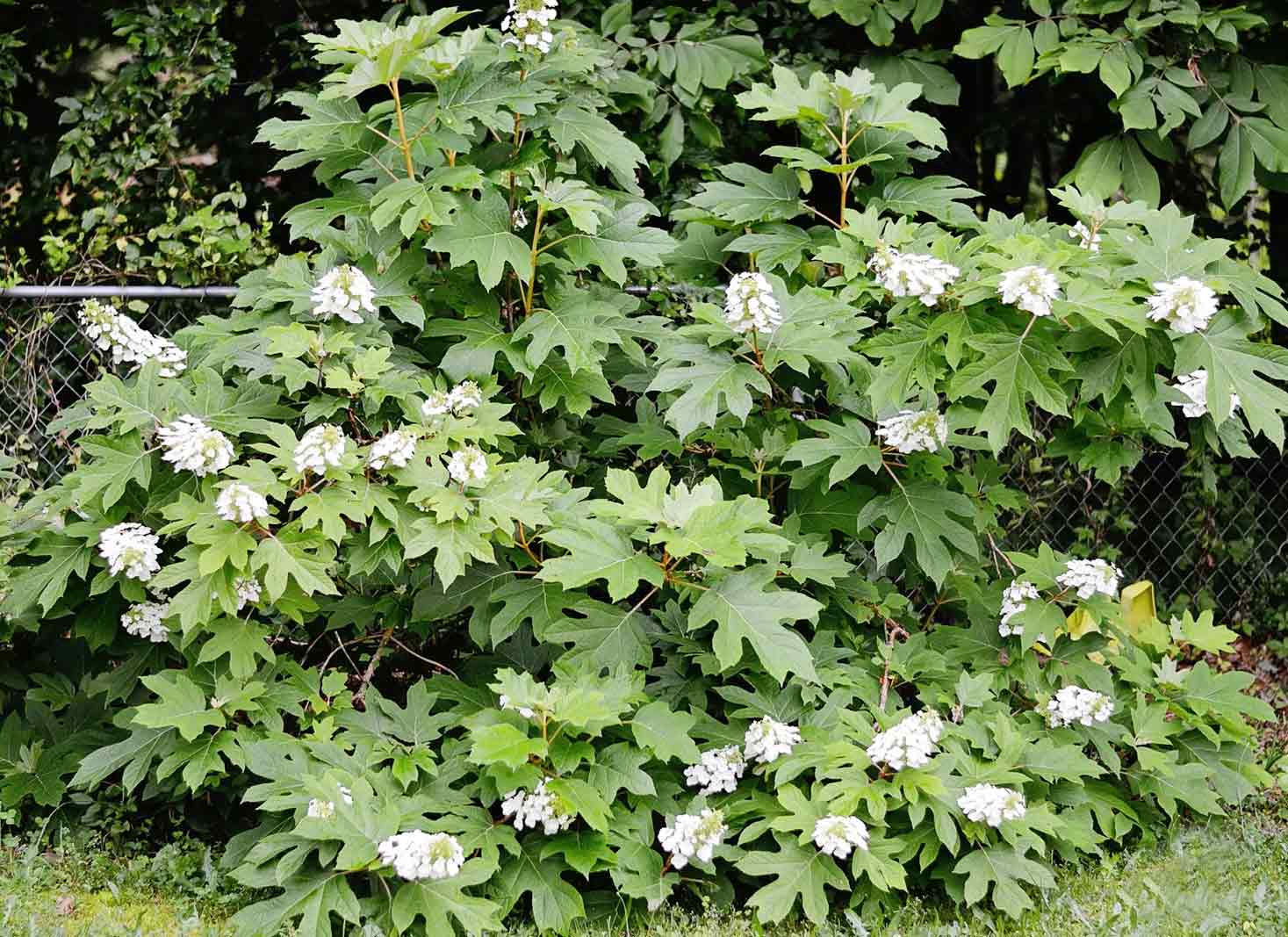
- Scientific name – Hydrangea quercifolia
- Description – this shrub grows very tall and wide with large leaves that resemble those of an oak tree. The leaves change colors in autumn and produce flowers in spring.
- Maturity size – 6- 8 feet tall and 6 ft in width.
- Level of care – minimal. Very good plant for novices or bad gardeners.
- Hardiness Zone – zones 4 – 9
- Best conditions – full sunlight to partial shade, well-drained, and fertile soil.
The oakleaf hydrangea shrub is one of the best shrubs for fence lines. The leaves of the shrub resemble those of the oak plant. They change color in the autumn and produce white flowers in spring. The hydrangea grows to about 6 – 8 feet long and wide on average.
This shrub requires minimal care and is a good choice for non-garden interest paper. They grow well in full to partial sunlight, well-drained, and fertile soil.
8. Lavender Rhododendron Shrub

- Scientific name – Rhododendron catawbiense
- Description; this shrub is a versatile option that can grow anywhere in the United States. The shrub grows moderately and has dense foliage. It produces bright purple flowers in the spring.
- Maturity size – 8 – 10 feet tall and 5 feet in width.
- Level of care – minimal
- Hardiness Zone – zone 4 – 8
- Best conditions – full sunlight to partial shade, well-drained, and fertile soil.
The lavender rhododendron shrub is one of the best shrubs for fence lines. This shrub is one of the most versatile shrubs in the United States. This means the shrub grows in most parts of the USA regardless of weather, cur, etc. The shrub has dense foliage which grows moderately. The lavender rhododendron can grow to about 8 – 10 feet tall and 5 feet in width.
9. Camellia ‘Shi-Shi Gashira’ Shrub
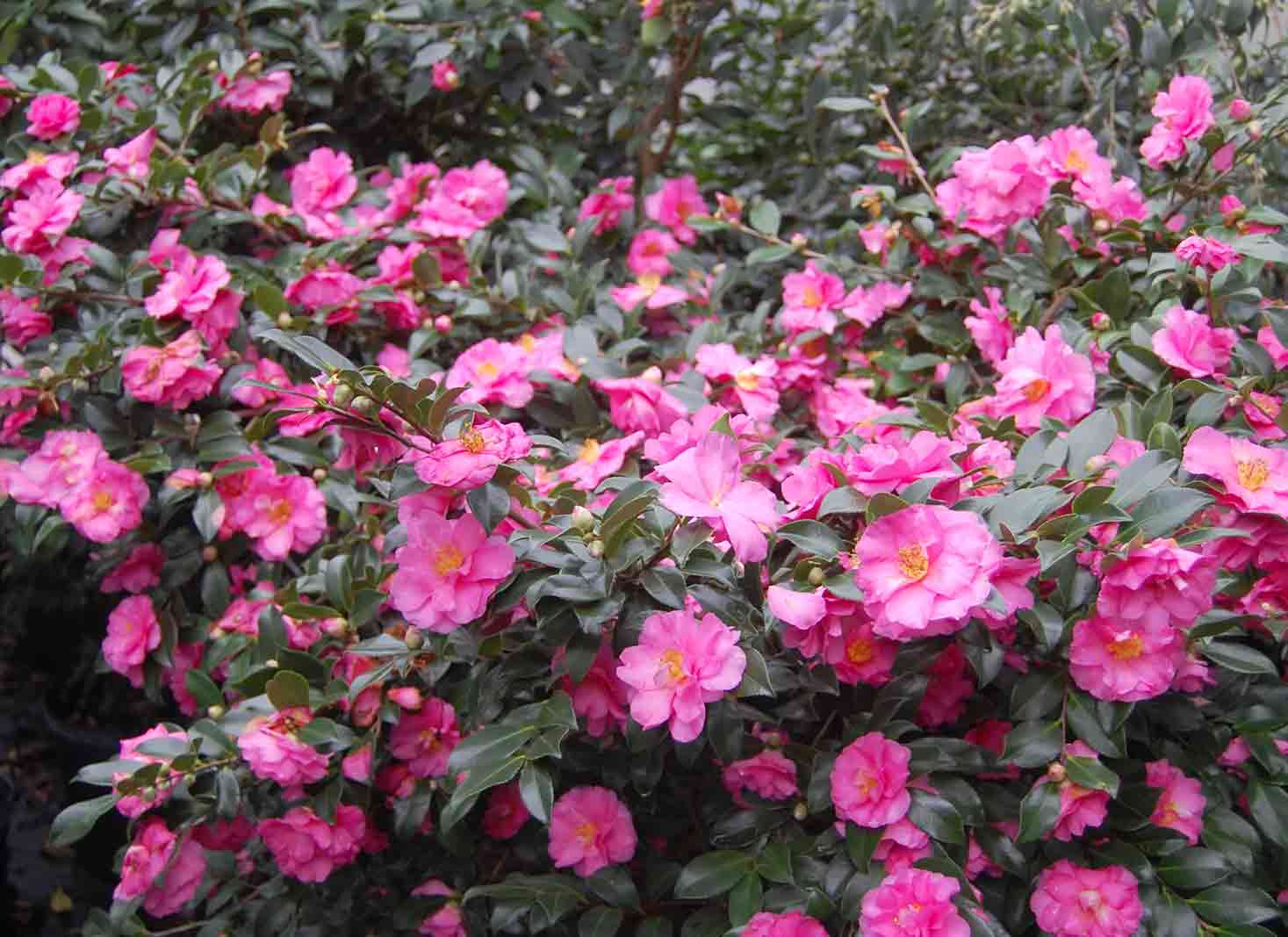
- Scientific name – Camellia sansanqua ‘Shi-Shi Gashira’
- Description – this shrub is a drought-resistant plant suitable for dry areas. They produce these pink flowers with yellow centers which add color to the decor.
- Maturity size – 5ft tall and wide.
- Level of care – minimal
- Hardiness Zone – zones 7 – 9
- Best conditions – full sunlight to partial shade, well-drained, and fertile soil.
The shi-shi gashira shrub is one of the best shrubs for fence lines. This shrub is one of the most resistant shrubs. They can survive for weeks without water and are suitable for areas with droughts and dry seasons.
These shrubs produce beautiful pink flowers that serve to attract men and animals. The shrub grows about 5ft tall and wide. They grow well in hardiness zones 7 – 8 and require minimal care.
10. Tri-Color Dappled Willow
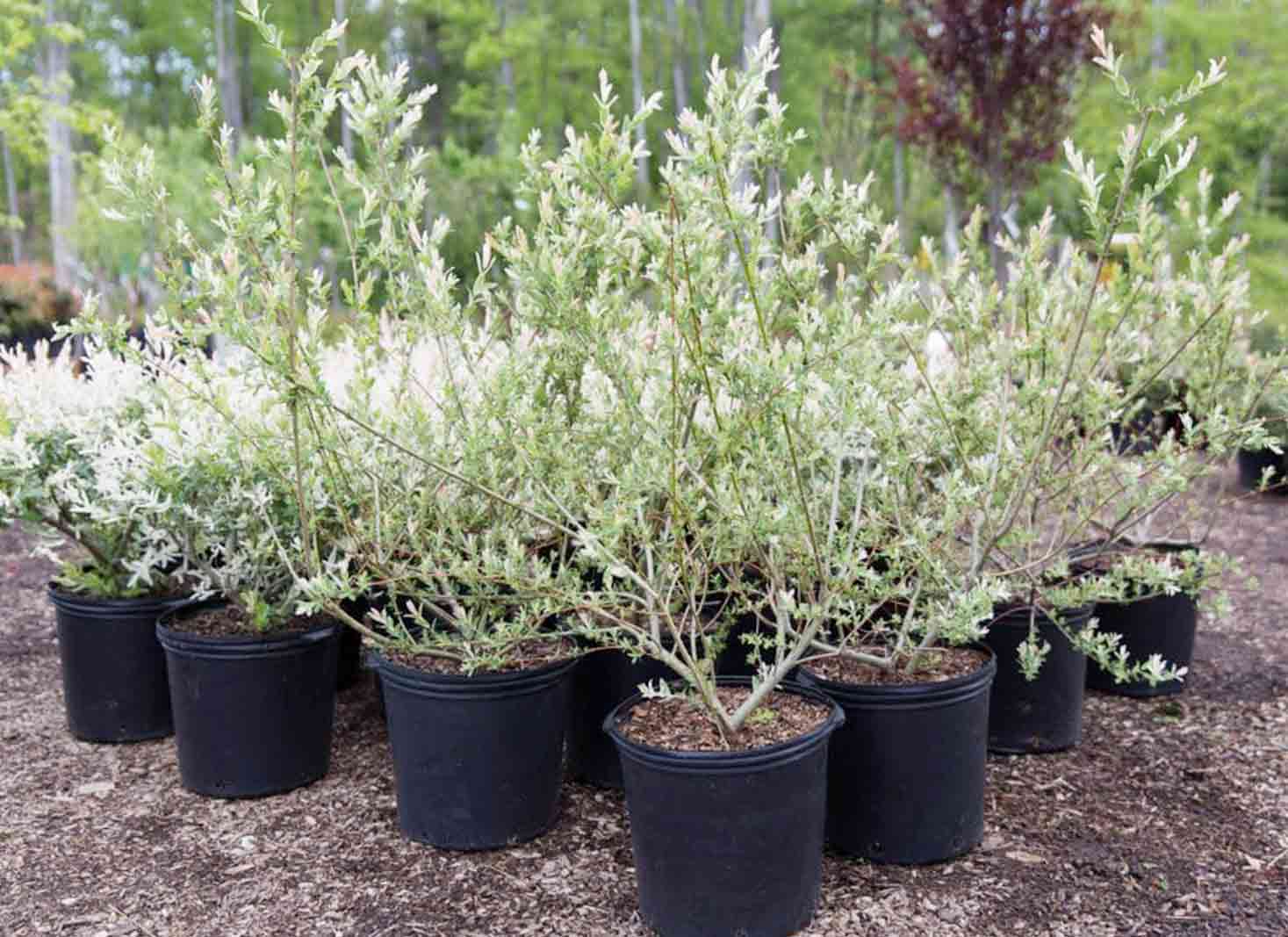
- Scientific name – Salix Integra ‘Hakuro-Nishiki
- Description; this shrub is one of the fastest-growing shrubs in the area. The shrub has three colors which are green, white, and pink. They give the plant its name as the tri-color willow.
- Maturity size – 8 – 10 feet tall and wide.
- Level of care – minimal
- Hardiness Zone – zones 5-9
- Best conditions – grows well in partial sunlight or under shade.
The tri-color dappled willow is one of the best shrubs for fence lines. This shrub is one of the fastest-growing shrubs. They have healing properties, grow to about 8 ft to 10ft tall, and have green, white, and pink suitcases.







